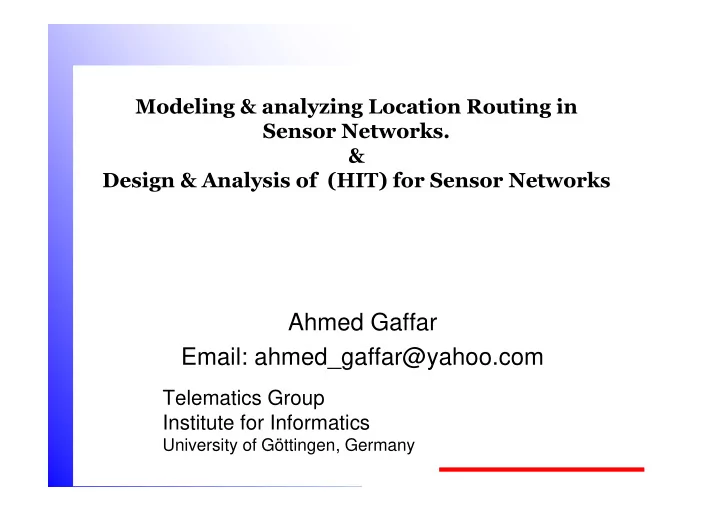

Modeling & analyzing Location Routing in Sensor Networks. & Design & Analysis of (HIT) for Sensor Networks Ahmed Gaffar Email: ahmed_gaffar@yahoo.com Telematics Group Institute for Informatics University of Göttingen, Germany
Telematics group University of Göttingen, Germany Table of contents: 1-Introduction 2-Background and related works 3-Inconsistency metrics 4-Simulation of Greedy Forwarding 5-Analysis & Simulation of Perimeter Mode in GPSR 6-Conclusions Advanced Topics in Mobile Communications (SS’04) 2
Telematics group University of Göttingen, Germany 1-Introduction Why Modeling analyzing Impact location inconsistence? • wireless communication devices are gaining more pupular. • Location information has important meaning especially in Sensor networks. • In mobile ad-hoc networks nodes moving, routing is a challenging task. • Gegraphic routing for ist several merits is better than topology-based routing. Advanced Topics in Mobile Communications (SS’04) 3
Telematics group University of Göttingen, Germany 2- Background and related works • Existing ad-hoc protocols can be divided into tow approaches 1. topology-based routing , uses link information of the networks to perform packet forwarding. 2. Position-based routing, uses physical location information to perform packet forwarding. Advanced Topics in Mobile Communications (SS’04) 4
Telematics group University of Göttingen, Germany 2.2 – gegraphic routing can be catogrized into three approches depending on the forwarding strategies: 2.2.1 – Greedy packet forwarding. 2.2.2 – restricted directional flooding. 2.2.3 – Hierarchail routing. Advanced Topics in Mobile Communications (SS’04) 5
Telematics group University of Göttingen, Germany 3- Inconsistency metrics 3.1 – Absolute Location Inaccuracy 3.2 – Relative Distance Inaccuracy. 3.3 – Absolute Location Inconsistency. 3.4 – Relative Distance Inconsistency. Advanced Topics in Mobile Communications (SS’04) 6
Telematics group University of Göttingen, Germany Advanced Topics in Mobile Communications (SS’04) 7
Telematics group University of Göttingen, Germany 4 – Simulation of Greedy Forwarding • Tools 1- the original NS-2 code for GPSR was used. 2- 250m of radio range. 3- Gaussian distribution (with zero mean), with different standard deviation to generate location inaccuracy. 4- Location inaccuracy is added to true location. Advanced Topics in Mobile Communications (SS’04) 8
Telematics group University of Göttingen, Germany 4.1- Simulation Parameters Advanced Topics in Mobile Communications (SS’04) 9
Telematics group University of Göttingen, Germany 4.2 – Impact in Drop Rate Advanced Topics in Mobile Communications (SS’04) 10
Telematics group University of Göttingen, Germany 4.3 – Impact on Optimal Path Advanced Topics in Mobile Communications (SS’04) 11
Telematics group University of Göttingen, Germany 4.4 – Impact on looping Advanced Topics in Mobile Communications (SS’04) 12
Telematics group University of Göttingen, Germany Conclusions Advanced Topics in Mobile Communications (SS’04) 13
Telematics group University of Göttingen, Germany Design and Analysis of (HIT) in Micro Sensor Networks 1 – Introduction . 2 – Basic Models. 3 – HIT Protocol Description. 4 – Performance Evaluation . 5 – Future Application of HIT. 6 – Conclusion. Advanced Topics in Mobile Communications (SS’04) 14
Telematics group University of Göttingen, Germany 1 – Introduction and Related Studies 1 – The sensor networks task is to sense the environment, and relay the information back to a remote base station, where the user can access it. 2 – Reducing the energy consumption is very important in these networks. 3 – the purpose of this paper : � Introduce Hybrid Indirect Transmission (HIT) � Testing (HIT) with a simulation test. Advanced Topics in Mobile Communications (SS’04) 15
Telematics group University of Göttingen, Germany 2 – Basic Models 2.1 – Data Delivery Model 2.2 – Radio Model 2.3 – Analysis of Direct and Indirect Transmission 2.4 – Parallel Transmission. 2.5 – Analysis of TDMA versus CSMA. Advanced Topics in Mobile Communications (SS’04) 16
Telematics group University of Göttingen, Germany 3 – HIT Protocol Description � Clustring Phase 1-one or more cluster-head are selected . � Single Cluster, Rotation � Single Cluster, Rotation, Additional Selection Criteria. � Multiple Clusters, Random. 2- cluster-head Advertisement. 3- Cluster Setup using (CSMA) Advanced Topics in Mobile Communications (SS’04) 17
Telematics group University of Göttingen, Germany 3 – HIT Protocol Description � Routing Phase 1- Route Setup: each node know the upstreams from the neighbor, from the last Phase. 2- have a knowlidig which is downstream nighbor, and which is upstream nighbor. 3- Blocking Set Computation(CSMA): each node computes the blocking set for it´s downstream neighbor. Advanced Topics in Mobile Communications (SS’04) 18
Telematics group University of Göttingen, Germany 3 – HIT Protocol Description � Schedule Phase 1- TDMA Schedule Setup: allows close the maximum number of nodes to communicate in parallel, computed by each node. 2- Data Transmission (TDMA) :sensing the enviroment and transmits to the upstream neighbor, following the TDMA schedule. Advanced Topics in Mobile Communications (SS’04) 19
Telematics group University of Göttingen, Germany 5 – Future Application for HIT � Bioelectric Computer Interface � HIT for EMG Sensing in Bioelectric Computer Interface. Advanced Topics in Mobile Communications (SS’04) 20
Telematics group University of Göttingen, Germany 6- Conclusion � The paper has described HIT (and HIT m for multiple cluster). � Performance evaluation has shown that HIT provides energy savings over LEACH and PEGASIS. � This advantage becomes more significant for large areas or large number of nodes. � HIT reduces the delay required to gather data. Advanced Topics in Mobile Communications (SS’04) 21
Telematics group University of Göttingen, Germany Thank you for your attention! Advanced Topics in Mobile Communications (SS’04) 22
Recommend
More recommend